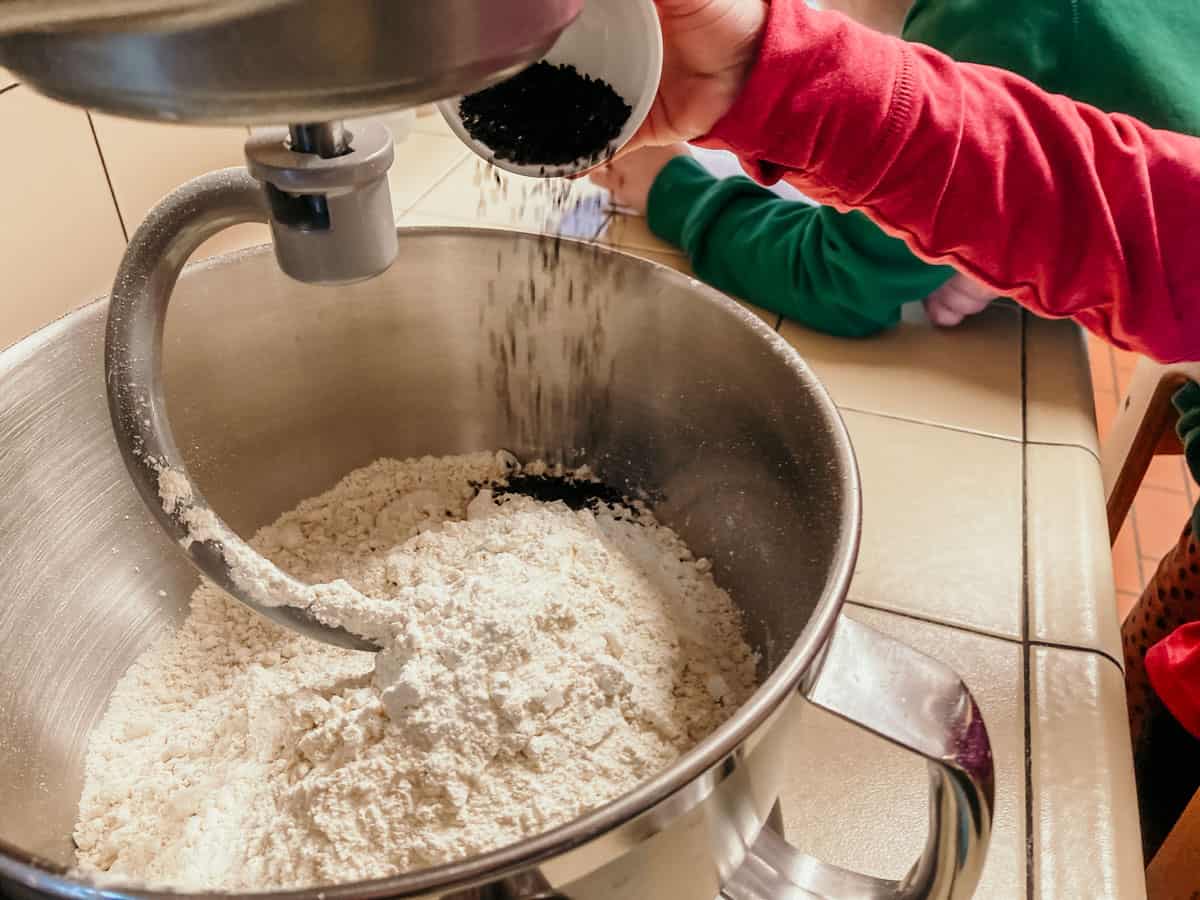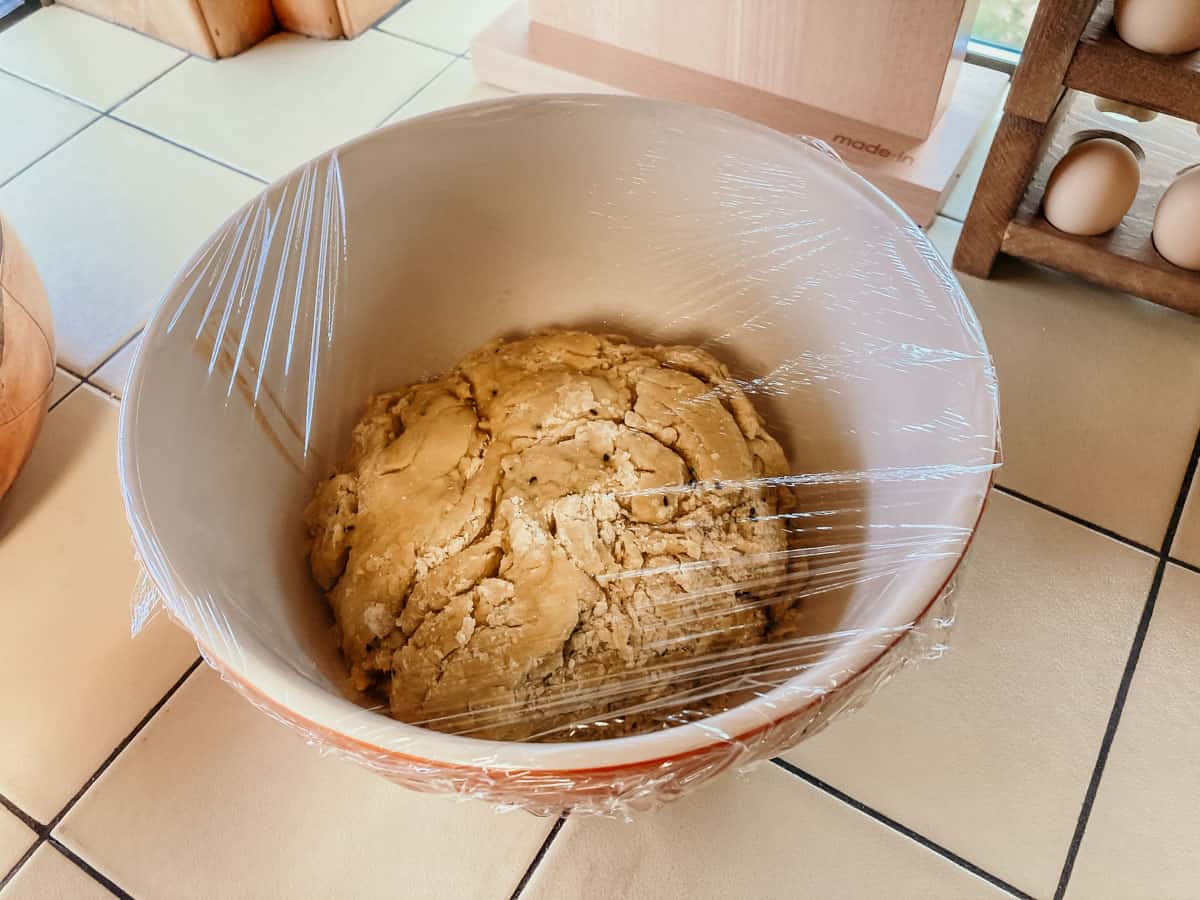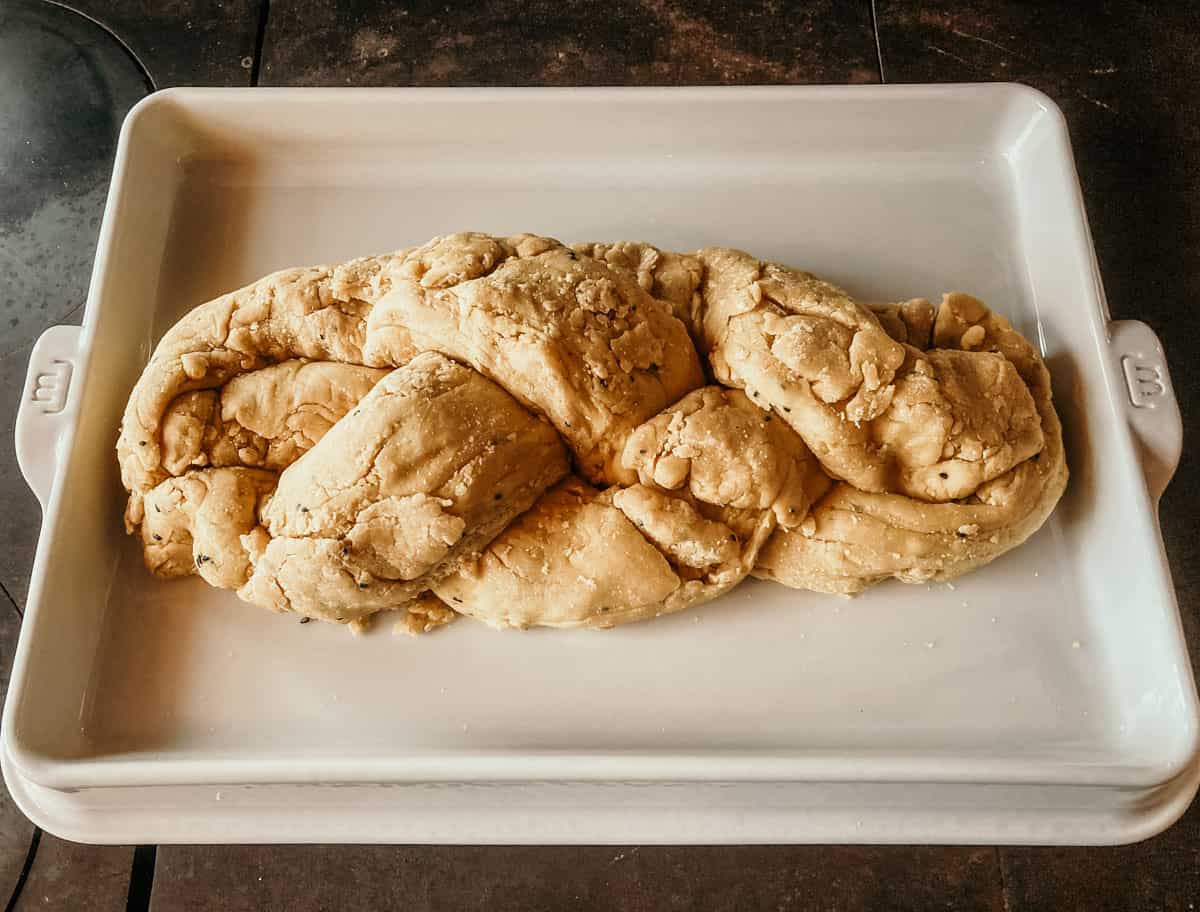
"The Fertile Crescent - the Cradle of Civilization where agriculture originated, or more recently - the Middle East, has long been a major center of world affairs...The first strokes of writing - the cuneiform script - were taken in this region and then used to record, on stone tablets, the oldest recipes known to man around the seventeenth century BCE."
- Reem Kassis
We love learning how to make different types of bread during our time in the kitchen and today we're sharing a delicious turmeric and nigella easter bread recipe.
With about an hour and a half of hands-on time, you can make a rich loaf of easter bread to enjoy year-round.
Grab your FREE recipe with pics below.
Learn more about how to cook with kids.
If you like this easter bread, you should try creamy baba ghanouj, matzo balls, easy sourdough bread, benne seed biscuits, cornbread, this pasta bake, Ukrainian bread, bannocks, cabbage pie, and Christmas cookies.
Disclosure of Material Connection: Some of the links in the post are “affiliate links.” This means if you click on the link and purchase the item, I will receive an affiliate commission. Amazon links are not affiliate links. You can read my full affiliate disclosure.

The Arabesque Table
This turmeric and nigella seed easter bread recipe comes from The Arabesque Table: Contemporary Recipes from the Arab World by Reem Kassis.
It's an excellent resource to accompany any studies on the Middle East, whether the interest lies in food, history, or culture. As Reem shares:
"It is a journey from the earliest Arabic cookbooks on record to the dishes being cooked by cutting-edge Arab chefs and home cooks across the region and abroad."
- Reem Kassis
Learn more about Reem Kassis.

related recipe!
Focaccia
A focaccia bread so satisfying, you can't call it work.
You can also stop by our shop to see more Family & Kids' Cooking Resources.
Family & Kid's Cooking Resources
Beautiful and diverse cooking resources for you!


Ancient Civilizations
Want to learn more about ancient civilizations?
Timelines of Everything covers many topics, including an example of cuneiform as seen above, and other early forms of written language.
Montessorikiwi's Ancient Civilizations Bundle is a grab-and-go resource with hands-on materials for exploring Ancient Egypt, Ancient Persia, and Ancient China.

Montessorikiwi
Receive a 16% Off Coupon + shop Montessori printables.

Food from Around the World: Free Cooking Lessons
Learn from some of the most talented chefs around the world!
Free Cooking Course for Families
Discover recipes for every continent! Sign up to receive free cooking lessons for the whole family. Learn from some of the most talented chefs around the world and participate in the quality practical life experiences Montessori education is known for.
Find out more about the cooking course.
As written in The Arabesque Table:
"Baking Easter bread is a common tradition among the Greek Orthodox community across the world. In the Levant, there is a sweet mahlab and mastic-flavored bread made specifically by the orthodox Christian community, but there is also a traditional anise-flavored bread made around Muslim and Christian holidays alike. This recipe took inspiration from both, creating a rich, sweet loaf, but flavored but flavored with turmeric and nigella seeds like numerous Arab pastries. The result is striking - a deep yellow-hued, braided (plaited) loaf, dotted with black seeds throughout, and complemented by a sweet flavor and tender crumb."
- Reem Kassis
Nigella sativa, nigella seeds, black cumin, etc. are small black seeds with a slightly bitter flavor. They typically grow in Egypt and India and are commonly used as a pastry topping.
According to Food Republic:
"Nigella sativa seeds were said to have been found in King Tut’s tomb and have been used for thousands of years as a preservative, a spice, and as the Prophet Muhammad claimed, a seed with healing powers."
- Food Republic
There are two styles of braiding mentioned in The Arabesque Table. The first style seen above includes 5 ropes of dough while the second style next to it is a simpler braiding technique using 3 ropes.
When learning how to braid the dough, we've found it's best to practice using other materials, such as embroidery floss and a clipboard. This way kids can take their time and the bread ingredients don't spoil.
Braiding Option 1 - 5 Ropes

For this braid, you'll need five ropes. Here we're starting with blue, green orange, white, and yellow.
Move rope 1 over rope 3. Now we have green, orange, blue, white, and yellow.

Next, move rope 2 over rope 3. Now we have green, blue, orange, white, and yellow.
Finally, move rope 5 over rope 2.
Repeat this process of moving rope 1 over 3, rope 2 over 3, and then rope 5 over 2 until you've reached the end.
Braiding Option 2 - 3 Ropes

For this braid, you'll need three ropes. For this demo, we're starting with yellow, white, and blue.
Move the first rope over the center rope. Now we have white, yellow, and blue.

Next, move the last rope over the center. We have white, blue, and yellow.
Repeat this same process of moving the outer ropes over the center rope until you've completed the braid. When working with dough it's only a few moves until you're done.
We went with option 2, and it was a lot of fun to create.

How to Make Turmeric & Nigella Seed Easter Bread
This delicious sweet bread is versatile and can be enjoyed throughout the year. We've been enjoying it alone with butter and to sop up some bison stew.
Reem recommends pairing it with a cup of tea and a salty white cheese, such as halloumi or Akkawi.

Ingredients
- milk
- butter - unsalted butter is recommended
- stevia - this stevia & erythritol blend tastes just a bit sweeter than sugar. You can also use sugar
- salt
- flour - this all-purpose einkorn is an ancient grain that's easy to work with and tastier than some other flours we've used in the past
- nigella seeds - these organic nigella seeds are grown in Egypt and ethically sourced
- turmeric - this Pragati Turmeric boasts hints of marigolds, orange, sunshine, and honey
- active dry yeast
- eggs - we use farm-fresh eggs at room temperature
- vanilla extract
Equipment
- Prep Bowls
- Kitchen Scale
- Pan
- Stand Mixer
- Baking Slab
- Basting Brush
- Berkey water filter
- Bread Knife

1. Measure the Stevia
Wash your hands with soap and water. Measure the stevia (or sweetener of choice) using a kitchen scale. Kids can learn about units and conversions as they show readiness.

Kaia enjoys reading the recipes and exploring the cookbook with her siblings between steps.

2. Add the Milk, Stevia, and Salt to a Pan
Turn the stove on medium-low and heat up your pan. Pour the milk into the pan and add the stevia. Measure the salt with a measuring spoon and add that as well.


I should've known by the expression on Katalina's face that something was up. I was about to find out.

3. Add the Butter to the Pan
You can simply add the butter to the pan or launch it into the air as we did. I recommend the former.

Give it a stir. We typically use a wooden spoon when working with cast iron. Katalina is really into the whisk right now so we're going with it.
Once the butter is melted, turn off the stove and let it cool for 15-30 minutes.

4. Weigh the Flour Needed to Make Easter Bread
While the milk mixture is cooling, weigh the flour and transfer it to the stand mixer.
Using the lightweight mixing bowl that comes with the mixer never ends well for us. Imagine our kitchen, but white. Instead, we use a heavier ceramic bowl for this task.


5. Add Nigella Seeds, Turmeric, & Yeast to the Mixing Bowl
Use your measuring spoon or your spice spoon to add the appropriate amount of nigella seeds, turmeric, and yeast for making this easter bread.



Turn the mixer on low. Use the dough hook attachment to combine the ingredients. Turn off the mixer when finished.

6. Add 2 Eggs and the Vanilla to the Milk Mixture
Crack 2 eggs into the pan of cooled ingredients. Wash your hands. Measure the vanilla with a measuring spoon and add to the pan. Use a spoon or whisk to combine.

7. Add the Egg Mixture & Water to the Mixing Bowl
Turn the mixer on medium-low to knead. The dough should be smooth and elastic when finished.
If the dough is stiff, Reem suggests adding 1 teaspoon of water at a time until the dough is elastic.
Turn off the mixer.

8. Transfer the Dough to an Oiled Bowl & Rest
Add a small amount of oil to a clean bowl and swirl it around before adding the easter bread dough. You can turn the dough around in the bowl to cover it with the oil.
Cover it with a tea towel or plastic wrap and set it aside in a warm spot. The dough is ready when it's doubled in size, around 1 hour.


9. Braid the Dough for Making Easter Bread & Rest
Transfer your dough to a clean surface and use a dough scraper to separate it into the number of ropes you'll be needing for your braid, 3 or 5.
Don't do what we did. Braid your dough in the baking slab or baking sheet you're going to bake it in. After we braided our dough, I used an Uncle Buck-sized spatula to carefully transfer it to the baking slab. Way easier to braid it where you bake it.
See the step-by-step at the top for braiding options. Press the ends together and tuck them under the loaf.
Cover with a damp tea towel. Let it rest for 1 hour.


10. Apply an Egg Wash, Sprinkle With Nigella Seeds, and Bake
Turn the oven to 350 degrees Fahrenheit.
Crack the remaining egg into a bowl and whisk. Use a basting brush to apply the egg wash to the entire loaf.
Sprinkle more nigella seeds on top.
Bake for 45-55 minutes.
Kaia is in the process of losing some baby teeth and growing in some adult ones, so we took it out of the oven just as soon as it was baked through. You could leave it in for a few extra minutes to achieve the rich brown color in the cookbook.
The easter bread will be dark golden brown and hollow when it's tapped.

Turn off the oven when finished and let it cool for about 30 minutes.

Slice with a bread knife and serve warm.

Free Turmeric & Nigella Seed Easter Bread Recipe
For you to try at home!
Free Easter Bread Recipe for Pre-Readers and Up
Grab your free printable recipe cards above. Kids can gather ingredients using the ingredient list, gather their equipment with the tools list, and prepare the meal using the step-by-step recipe cards, with assistance as needed.

Turmeric & Nigella Seed Easter Bread
Equipment
- Pan
- Spoon
- Plastic Wrap
Ingredients
- 1 cup whole milk
- 6 tablespoon unsalted butter
- ¾ cup stevia
- 1 teaspoon salt
- ¼ cup water
- 5 ¾ cups all-purpose einkorn flour
- 2 tablespoon nigella seeds plus more for sprinkling
- 1 tablespoon turmeric
- 2 ¼ teaspoon active dry yeast
- 3 eggs
- ½ teaspoon pure vanilla extract
Instructions
- Wash your hands with soap and water. Measure the stevia (or sweetener of choice) using a kitchen scale. Kids can learn about units and conversions as they show readiness.
- Turn the stove on medium-low and heat up your pan. Pour the milk into the pan and add the stevia. Measure the salt with a measuring spoon and add that as well.
- Add the butter to the pan. Give it a stir. Once the butter is melted, turn off the stove and let it cool for 15-30 minutes.
- While the milk mixture is cooling, weigh the flour and transfer it to the stand mixer.
- Use your measuring spoon or your spice spoon to add the appropriate amount of nigella seeds, turmeric, and yeast for making this easter bread. Turn the mixer on low. Use the dough hook attachment to combine the ingredients. Turn off the mixer when finished.
- Crack 2 eggs into the pan of cooled ingredients. Wash your hands. Measure the vanilla with a measuring spoon and add to the pan. Use a spoon or whisk to combine.
- Add the egg mixture and water to the mixing bowl. Turn the mixer on medium-low to knead. The dough should be smooth and elastic when finished. If the dough is stiff, Reem suggests adding 1 teaspoon of water at a time until the dough is elastic. Turn off the mixer.
- Add a small amount of oil to a clean bowl and swirl it around before adding the easter bread dough. You can turn the dough around in the bowl to cover it with the oil. Cover it with a tea towel or plastic wrap and set it aside in a warm spot. The dough is ready when it's doubled in size, around 1 hour.
- Braid your dough in the baking slab or baking sheet you're going to bake it in. You can use parchment paper for a baking sheet. Cover with a damp tea towel. Let it rest for 1 hour.
- Turn the oven to 350 degrees Fahrenheit. Crack the remaining egg into a bowl and whisk. Use a basting brush to apply the egg wash to the entire loaf. Sprinkle more nigella seeds on top. Bake for 45-55 minutes. The easter bread will be dark golden brown and hollow when it's tapped. Turn off the oven when finished and let the loaf cool for about 30 minutes.
Notes
- The same amount of sugar or other sweeteners can be substituted for stevia
- Can be covered at room temperature for up to 2 days or frozen for 1 month
- Never leave cooking food unattended
- Always have good ventilation when using a gas stove
- See more guidelines at USDA.gov
- Full Lesson Info and Pictures at: https://happyhomeschooladventures.com/easter-bread
Nutrition
Estimated nutrition information is provided as a courtesy and is not guaranteed.






Leave a Reply